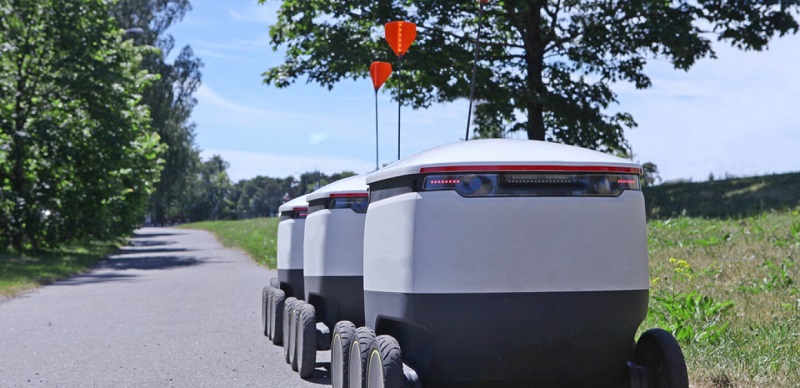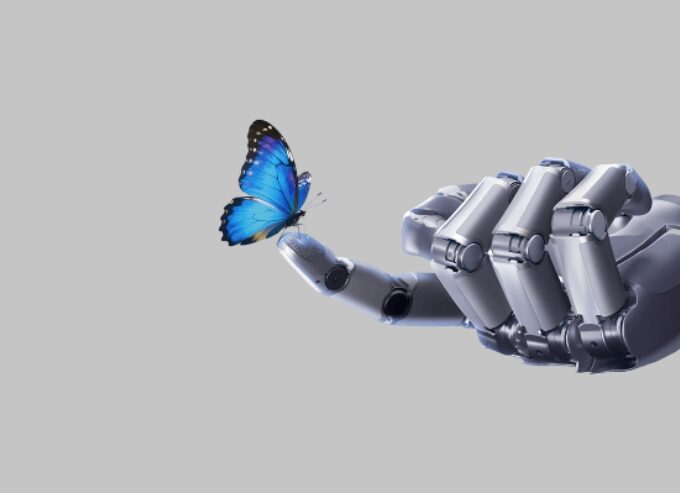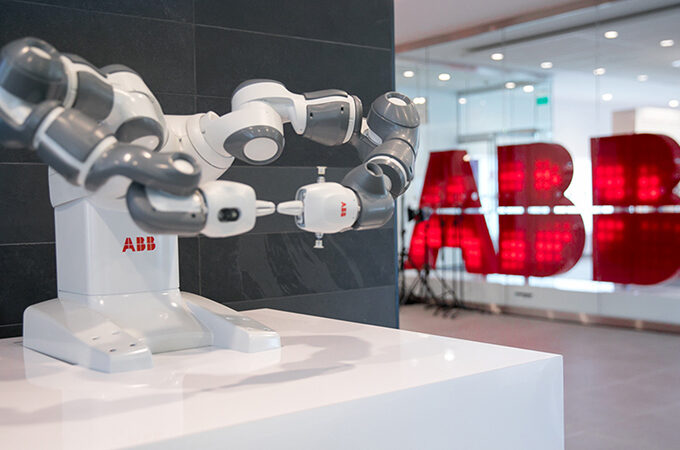The role of AGVs (Automated Guided Vehicles) and AMRs (Autonomous Mobile Robots) in logistics and manufacturing is expanding. With labor shortages, AGVs and AMRs that can work alongside people in factories and warehouses are becoming valuable assets across the industry.
However, AGVs require guidance devices such as tapes or 2D markers on the floor to set up routes, while AMRs cannot be run immediately after purchase. There is a high level of risk as navigation plans and mapping need to be in place before the system can be operated, so it takes a lot of time and money to implement. There is also the consideration of emergency response and maintenance in the event of problems. Many people find that the high costs are simply not worth the effort of automation – depending on the tasks they want to assign to the AGV or AMR.
As a result, ROHM is quietly developing a new cost-effective robot navigation technology that can be rapidly deployed in situations where AGVs and AMRs are inconvenient or unnecessary. This represents an entirely new type of robotic solution that could bring greater convenience to society in the future. In this article, we will discuss ROHM’s new navigation technology, NoMaDbot™ (No Map Driving Robot). *NoMaDbot™ is a trademark or registered trademark of ROHM Co.
Challenges in the Field Following the Widespread Adoption of AGVs and AMRs
As intelligent technologies continue to advance, transport robots such as AGVs and AMRs are expanding their role in industrial facilities, factories, and logistics sites. However, with this progress, several challenges have emerged.
AMRs have received particular attention in recent years because of their advanced features that can improve the operating environment. However, many are hesitant to introduce such systems for many reasons, including high implementation costs, the need for specialized SIers (system integrators: engineers who build systems), time-consuming set-ups, and frequent systems.

For example, transporting an object from A to B with a conventional AGV requires the installation of guide rails that use tapes and the like. AMR, on the other hand, is more complex, utilizing a technology called SLAM (Simultaneous localization and Map Building) to simultaneously perform self-localization and mapping. However, implementation requires specialized engineers known as SIers to design the specification and navigation plan for the facility, as the system can only operate once a map has been created. As a result, it can take up to several months after purchase to become fully operational. Additionally, if the facility layout changes, the entire process may have to be repeated.

While high-performance transport robots such as AMR are effective in environments where routes are complex, facility accuracy and speed are required, and layouts do not change over time, advanced performance and coordination features are not required for simple tasks such as transporting waste or defective products to a disposal area or delivering packages from A to B. At the same time, the time-consuming process of building map-based systems poses a significant barrier to the adoption of existing transport robots in environments with frequently changing layouts such as distribution warehouses, supermarkets, and event halls.
Is it possible to build a simpler, lower-cost, “handling-only” transport robot? Based on such customer feedback, Röhm has started to develop a new robot navigation technology called NaMaDbot™.
Creatures Get to Their Destinations Without Maps
The development of NoMaDbot™ started from the premise that “living things don’t need maps to get to their destinations”. For example, animals and insects travel to their destinations based on general directions, approximate distances, and situational judgments at the time.
The same is true for humans. We may rely on maps and navigation when traveling long distances, but not when going to the local supermarket. Even if you’ve never been to a supermarket, you should be able to get there if you know the general direction and distance. Also, if the road is closed due to construction or there are obstacles such as parked cars, you can quickly adapt to the situation by avoiding or taking a detour.
The question then becomes, “Is it possible to equip transport robots with flexible autonomous navigation capabilities similar to those of living creatures?”
The goal of the NoMaDbot™ development team was to determine how to estimate the approximate direction to a destination while detecting and avoiding obstacles along the way.

NoMaDbot™ Company Technology: Determining Direction
NoMaDbot™ stands for mapless robot. It means autonomous driving technology that does not use maps. The first core technology that makes this possible is “direction estimation”, which is used to determine the direction to a destination. For the NoMaDbot™, the destination is a smart tag that acts as a transmitter (in the future, this could be a smartphone.) The NoMaDbot™ detects the radio waves emitted from the transmitter to estimate its direction.
It can only head towards the destination smart tag, but this is sufficient for simple transport purposes. Although it is not possible to program complex routes like AMR, by combining multiple smart labels and switching them sequentially, it is possible to perform operations such as “transport the parcel from A to B and then to C”.

NoMaDbot™ Core Technology: Echolocation
Another core technology is “echolocation”, which is used to avoid obstacles along the way. Echolocation is the process of detecting and understanding the distance, direction, and size of an object by analyzing the emitted ultrasound or the reflection of sound. The technology is inspired by dolphins, whales, and bats, which use echolocation for spatial perception. Incorporating echolocation into its navigation algorithms allows NoMaDbot™ to detect and avoid obstacles.

Direction Estimation and Echolocation
Combining the two core technologies of Direction Estimation and Echolocation enables the world’s first new map-less autonomous driving technology.
While it may not provide the advanced coordination and control of traditional SLAM-based AMR, it is ideally suited to a wide range of situations where the task is simply “transporting goods”. Additionally, the adoption of this new navigation technology eliminates the need for SIers to build map-based systems that can be operated immediately from day one. And, of course, it’s not affected by changes in facility layouts or operational locations.

Further Benefits of Mapless Robot Driving Technology
The benefits of not needing maps go beyond cost reduction and faster implementation. Since no maps are used in the first place, the system never freezes due to loss of position. In other words, it’s a robust self-driving system that can withstand the unexpected.
At the same time, the NoMaDbot™ driving algorithm does not target fixed points on the map, but rather transmitters such as smart tags, so that even if the destination moves, it can be reached without any problems as long as it is within radio range. It can also perform tasks that are difficult with conventional SLAM-based driving technology, such as “delivering a parcel by following Mr. A, whose position changes in real-time,” or “tracking and transporting a parcel after Mr A.”
Why Did ROHM Start Developing Autonomous Driving Technology?
ROHM wants to realize a society where everyone can use autonomous robots.
ROHM is using many of the fundamental technologies such as MEMS, AFEs, and small MCUs to create new solutions that are consistent with its expertise in the field, including the world’s first drive technology, NoMaDbot™.

NoMaDbot™ Application Areas
ROHM would like to emphasize that NoMaDbot™ is not intended to deny or compete with AGV or AMR technology.
While AGVs are used where travel routes are predetermined, and AMR is used where full automation is required, NoMaDbot™ is ideal where inexpensive and simple automation is required.
For example, the layout changes frequently depending on the time of day or season, such as in transit warehouses, or where items need to be passed from one person to another, such as in supermarkets, event halls, and construction sites. It is suitable for places such as factories where undesirable goods and waste other than goods are transported. It is simpler and more convenient than AGVs and AMRs if the only task is to transport items. That’s where NoMaDbot™ comes in.

As development progresses, we can expect to see even more convenient and wide-ranging applications and environments, such as tracking people carrying smart tags or linking to smartphone apps.

NoMaDbot™ Vision for the Future of Industrial Society
The goal of NoMaDbot™ is to “create a society where everyone can use autonomous robots”. The use of simple transport robots that can move more easily at lower costs without the need for high-performance robots will increase productivity and help promote automation in manufacturing and logistics.
In addition, by utilizing the concept of sensor fusion, the NoMaDbot™ has the potential for further development. Although we are currently developing the system only on the ground, we plan to realize operation in special environments such as the sky and the ocean in the future.













